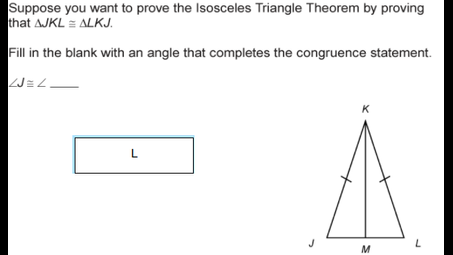What else can I help you with?
What is the Converse of isosceles triangle theorem?
The isosceles triangle theorem states that if two sides of a triangle are congruent, the angles opposite of them are congruent. The converse of this theorem states that if two angles of a triangle are congruent, the sides that are opposite of them are congruent.
The isosceles triangle theorem states that if two sides of a triangle are congruent then the opposite those sides are?
The isosceles triangle theorem states that if two sides of a triangle are congruent, then the angles opposite those sides are congruent.
What is the Isosceles Triangle Theorem in Geometry?
The Isosceles Triangle Theorem:If two sides of a triangle are congruent, then the angles opposite the sides are congruent.The Converse of Isosceles Triangle Theorem:If two angles of a triangle are congruent, then the sides opposite those angles are congruent.
Does the Isosceles Triangle Theorem states that if two sides of a triangle are congruent then the angles of those sides are congruent?
Yes an isosceles triangle has two equal sides and two equal angles.
Can an isosceles triangle Always be a right triangle?
In an isosceles triangle, two angles, and therefore sides (Base Angle Theorem), are congruent. This does not mean that all isosceles triangles are also right triangles - there is only one (45, 45, 90 triangle).
What is the Converse of isosceles triangle theorem?
The isosceles triangle theorem states that if two sides of a triangle are congruent, the angles opposite of them are congruent. The converse of this theorem states that if two angles of a triangle are congruent, the sides that are opposite of them are congruent.
Does the Pythagorean theorem work on isosceles triangles?
it depens if the isosceles triangle is a right triangle or not
The isosceles triangle theorem states that if two sides of a triangle are congruent then the opposite those sides are?
The isosceles triangle theorem states that if two sides of a triangle are congruent, then the angles opposite those sides are congruent.
Is Pythagorean theorem applicable on isosceles right triangle?
YES
complete the paragraph proof?
converse of the isosceles triangle theorem
which completes the paragraph proof?
converse of the isosceles triangle theorem
IF you are using this figure to prove the isosceles triangle theorem would be the best strategy?
To prove the Isosceles Triangle Theorem using a figure, the best strategy is to focus on the properties of the triangle's angles and sides. Start by labeling the two equal sides and their opposite angles. Then, use triangle congruence criteria, such as the Side-Angle-Side (SAS) or Angle-Side-Angle (ASA), to establish that the two triangles formed by drawing a line from the vertex to the base are congruent. This congruence will demonstrate that the base angles are equal, thereby proving the theorem.
What is the Isosceles Triangle Theorem in Geometry?
The Isosceles Triangle Theorem:If two sides of a triangle are congruent, then the angles opposite the sides are congruent.The Converse of Isosceles Triangle Theorem:If two angles of a triangle are congruent, then the sides opposite those angles are congruent.
Does the Isosceles Triangle Theorem states that if two sides of a triangle are congruent then the angles of those sides are congruent?
Yes an isosceles triangle has two equal sides and two equal angles.
Can an isosceles triangle Always be a right triangle?
In an isosceles triangle, two angles, and therefore sides (Base Angle Theorem), are congruent. This does not mean that all isosceles triangles are also right triangles - there is only one (45, 45, 90 triangle).
What does The isosceles triangle theorem state about two sides of a triangle?
The Isosceles Triangle Theorem states that in an isosceles triangle, which has at least two sides of equal length, the angles opposite those equal sides are also equal. This means that if two sides of a triangle are congruent, the angles opposite those sides will be congruent as well. This property is fundamental in triangle geometry and is useful for solving various geometric problems.
The Isosceles Triangle Theorem states that if two sides of a triangle are then the angles opposite those sides are congruent?
Congruent -gieco53-

